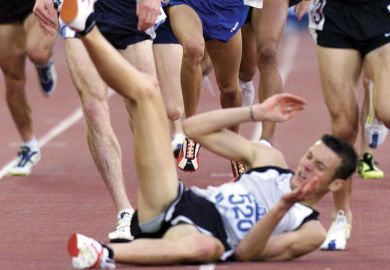US higher education is failing to win back many of its 40 million dropouts in large part because it is making the process of returning far more complicated than necessary, according to experts in a mentoring experiment that involved thousands of former students.
The dropout population – commonly dubbed “some college, no credential” – has become a leading concern for institutions and policymakers because they are regarded as among the most vulnerable of the 43 million people estimated to hold more than $1.7 trillion (£1.3 trillion) in student loan debt nationwide. Such borrowers represent one of the central motivations for President Joe Biden’s persistent and controversial campaign to enact broad student loan forgiveness.
To examine possible solutions, a research team from the University of Chicago and the University of Colorado Boulder put thousands of dropout students through a professional mentoring programme to see what difference it made. The answer: virtually none.
Many of the students embraced and appreciated the guidance, said a co-organiser of the project, Oded Gurantz, an assistant professor of education at Colorado. And while about a third of those who volunteered for the experiment did return to college, the mentoring appeared to make no real difference, as the returnees were about evenly split between the 4,000 who were given the professional assistance and the 4,000 who were not.
The reasons for students not returning were varied, and included many of the familiar challenges of cost, uncertainty and obligations to family and jobs. But the mentoring experiment made clear, Dr Gurantz said, that US higher education as a system looks needlessly unfriendly to dropouts trying to work their way back.
Even the study’s professional guidance counsellors, who typically work with high-school students entering college, were consistently frustrated by their own attempts to help the dropouts navigate the necessary steps, Dr Gurantz said.
“It seems like the challenges to re-enrolment are much bigger than something that the coach was able to solve with a few options,” he said.
Dr Gurantz and his co-author, Lesley Turner, an associate professor of public policy at Chicago, present their findings in a National Bureau of Economic Research working paper ahead of peer review.
Campus resource collection: Catching students before they fall
Students quitting college tend to “do so very inefficiently”, Dr Gurantz said. “Instead of formally withdrawing from their institution, they just stop going one day, and that creates a host of problems for them when they try to re-enrol.”
And colleges as a whole react poorly to such situations, he said, putting dropout students from their own institutions or from other campuses through laborious processes to regain their academic status, re-establish financial aid eligibility and meet other basic qualifications.
That logistical snarl compounds other basic uncertainties facing dropout students, such as deciding what professional training to pursue and assessing the cost-benefit of making another major investment of time and money, Dr Gurantz said. In that context, he said: “Getting this run-around on college campuses is very time-consuming and difficult and, frankly, demoralising.”
Register to continue
Why register?
- Registration is free and only takes a moment
- Once registered, you can read 3 articles a month
- Sign up for our newsletter
Subscribe
Or subscribe for unlimited access to:
- Unlimited access to news, views, insights & reviews
- Digital editions
- Digital access to THE’s university and college rankings analysis
Already registered or a current subscriber?








